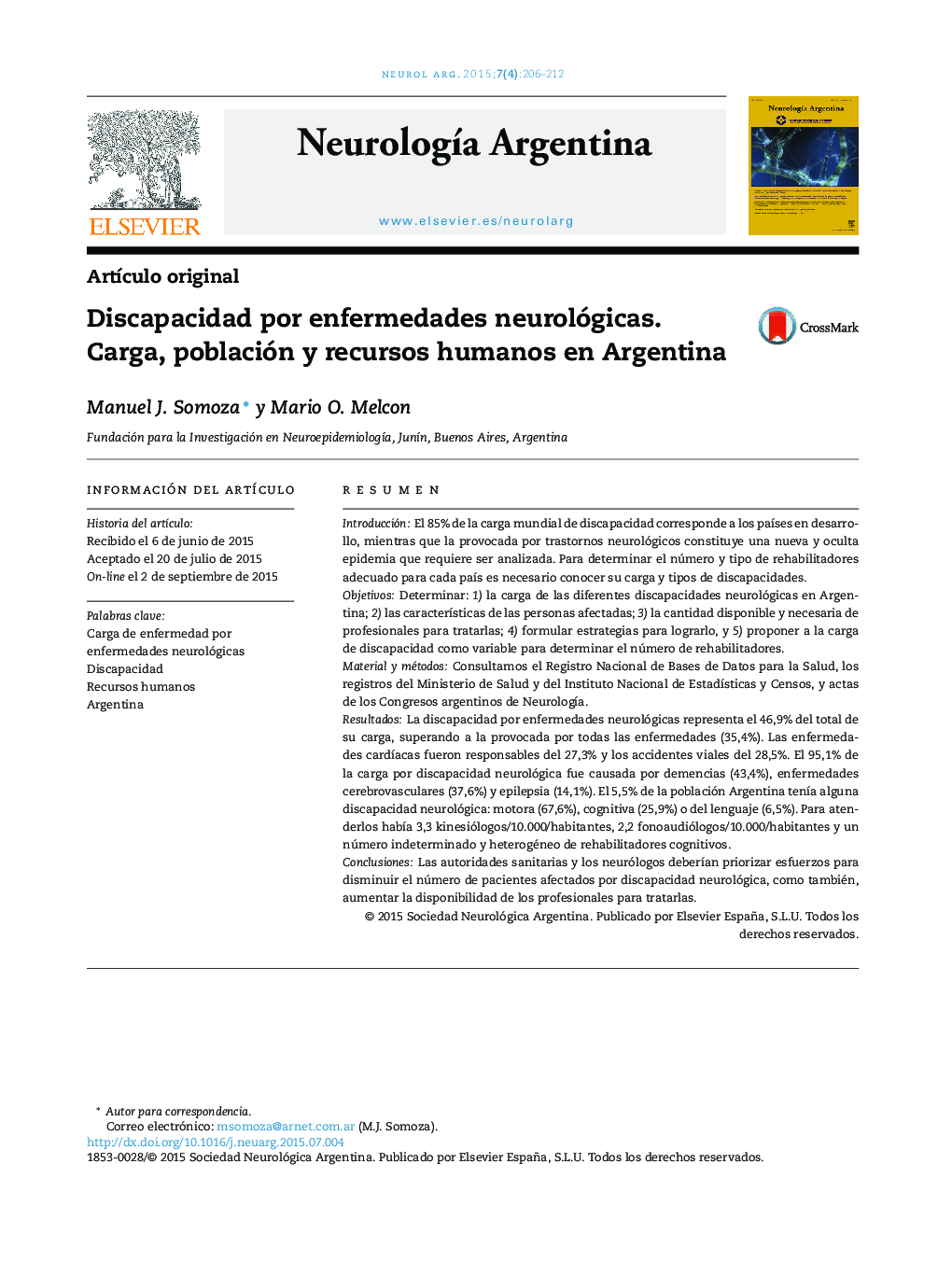| کد مقاله | کد نشریه | سال انتشار | مقاله انگلیسی | نسخه تمام متن |
|---|---|---|---|---|
| 3076552 | 1189088 | 2015 | 7 صفحه PDF | دانلود رایگان |
ResumenIntroducciónEl 85% de la carga mundial de discapacidad corresponde a los países en desarrollo, mientras que la provocada por trastornos neurológicos constituye una nueva y oculta epidemia que requiere ser analizada. Para determinar el número y tipo de rehabilitadores adecuado para cada país es necesario conocer su carga y tipos de discapacidades.ObjetivosDeterminar: 1) la carga de las diferentes discapacidades neurológicas en Argentina; 2) las características de las personas afectadas; 3) la cantidad disponible y necesaria de profesionales para tratarlas; 4) formular estrategias para lograrlo, y 5) proponer a la carga de discapacidad como variable para determinar el número de rehabilitadores.Material y métodosConsultamos el Registro Nacional de Bases de Datos para la Salud, los registros del Ministerio de Salud y del Instituto Nacional de Estadísticas y Censos, y actas de los Congresos argentinos de Neurología.ResultadosLa discapacidad por enfermedades neurológicas representa el 46,9% del total de su carga, superando a la provocada por todas las enfermedades (35,4%). Las enfermedades cardíacas fueron responsables del 27,3% y los accidentes viales del 28,5%. El 95,1% de la carga por discapacidad neurológica fue causada por demencias (43,4%), enfermedades cerebrovasculares (37,6%) y epilepsia (14,1%). El 5,5% de la población Argentina tenía alguna discapacidad neurológica: motora (67,6%), cognitiva (25,9%) o del lenguaje (6,5%). Para atenderlos había 3,3 kinesiólogos/10.000/habitantes, 2,2 fonoaudiólogos/10.000/habitantes y un número indeterminado y heterogéneo de rehabilitadores cognitivos.ConclusionesLas autoridades sanitarias y los neurólogos deberían priorizar esfuerzos para disminuir el número de pacientes afectados por discapacidad neurológica, como también, aumentar la disponibilidad de los profesionales para tratarlas.
IntroductionDeveloping countries account for 85% of the global burden of disability. Disabilities caused by neurological disorders constitute a new and hidden epidemic that needs to be analyzed. To determine the appropriate number and type of rehabilitators needed in each country, it is necessary to determine the types of disabilities and their burdens.ObjectivesDetermine 1) the burden of various neurological disabilities in Argentina; 2) the characteristics of people affected by these disabilities; 3) the number of professionals available and needed to treat these patients; 4) develop strategies to achieve these tasks, and 5) propose the burden of disability as a variable to determine the number of professionals.Material and methodsResearch data was obtained from the National Registry Database, the Argentine Ministry of Health, the National Institute of Statistics and Census, and the Argentine Congresses of Neurology.ResultsDisability by neurological diseases represents 46.9% of the total burden, greater than those caused by all diseases (35.4%). Heart disease accounts for 27.3% and traffic accidents are responsible for 28.5%. The majority (95.1%) of neurological disabilities were caused by: dementia (43.4%), cerebrovascular diseases (37.6%), and epilepsy (14.1%). 5.5% of the Argentinian population had some form of neurological disability: motor (67.6%), cognitive (25.9%) or language (6.5%). The density of professionals available to treat these patients was 3.3 physiotherapists/10,000 inhabitants, 2.2 audiologist/10,000 inhabitants, and an undetermined and heterogeneous number of cognitive professionals.ConclusionsHealth authorities and neurologists should make it a priority to reduce the number of patients affected by neurological disabilities, and to increase the availability of professionals to treat them.
Journal: Neurología Argentina - Volume 7, Issue 4, October–December 2015, Pages 206–212
